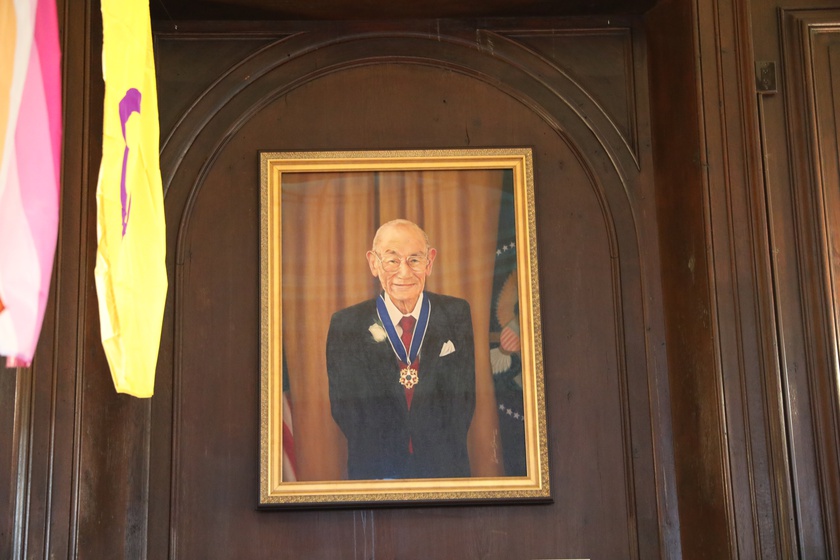{shortcode-42b03f7e505df3c1e5db81d12cff9d4d39abe2fd}
William Z. Shen ’22 had a childhood fear of oil painting.
“My art teacher said it came with a lot of toxic fumes,” Shen tells us over chicken fried rice at Harvard’s Longwood medical campus, where he is a first-year student.
In grade school, Shen dealt instead in graphite and acrylic. In seventh grade, he drew his first portrait — a tracing of President Obama which Shen’s teacher kept on his wall until he retired.
Luckily, the portraitist Stephen Coit ’71, Shen’s art mentor while an undergraduate at Harvard, eased his anxieties. “He taught me a technique which involves soap, that doesn’t involve the toxic chemicals,” he says. “So that was reassuring.”
Shen’s very first oil painting is now Adams House’s newest portrait on display: a portrait of Fred Korematsu, the Japanese-American civil rights hero and plaintiff in the famed 1944 Supreme Court case Korematsu v. United States. Korematsu challenged President Franklin D. Roosevelt’s Executive Order 9066, which mandated the internment of over 100,000 Japanese and Japanese-American people during World War II. Despite arguing that the relocation violated his rights, Korematsu lost the case in a 6-3 decision that has been highly criticized for apparent racism.
Shen’s portrait was unveiled during a ceremony held in the Adams library on Oct. 20, followed by a lecture from Japanese-American scholar Erin Aoyama ’15. Aoyama’s lecture situated Korematsu’s life and activism within the history of the political fight for Asian liberation in the United States.
The painting itself depicts Korematsu standing between the American and Presidential flags, wearing the Presidential Medal of Freedom President Bill Clinton gave him in 1998. Even in old age, he is radiant; Korematsu’s face is front-and-center, rendered in painstaking photorealistic detail. Shen took seventy hours to complete the portrait.
{shortcode-03d192d1f70bb9dcb347f5a79b1990ad1a6a2ee4}
In his process, Shen usually begins with a subject’s eyes, which he considers the most realistic part of his portraits. It’s important to “understand the emotional state and the context in which [the subject] sat for a photo so that you can better recapitulate that,” he says. “It’s something to do with the expression in their eyes.”
Korematsu was preoccupied with his own eyes: After FDR signed the Executive Order, Korematsu got plastic surgery on his eyes in an attempt to make himself look less Japanese, hoping to avoid internment by passing for Hawaiian.
Shen himself, though he has now shifted his focus to oncology, once wanted to be a reconstructive surgeon for people who had undergone physical trauma, a specialization that he felt would serve as a “great use of [his] artistic abilities in medicine.”
Indeed, anatomy informs Shen’s artistic process; after he lays down a background color, Shen starts with dark, colorful strokes that will contour the subject’s face. He refers to these preliminary strokes as “a little bit reminiscent of a muscle.”
While much of his early work merges medicine and art (he previously made graphics and digital art about health and science for organizations including the National Health Service in England), Shen now sees a greater separation between his two disciplinary interests. “I don’t really anticipate using much ‘fine art’ for a true medical purpose,” Shen says. He brings up the Longwood Symphony Orchestra, which is composed of professors, doctors, and medical students, as an example of medicine and art coexisting without overlap.
“I don’t think it’s a bad thing, having that disconnect, though, because I really view art as my creative outlet, something that can use the other side of my brain,” he says.
Shen’s portrait of Korematsu hangs beside a portrait of President Franklin D. Roosevelt, troubling the way the viewer receives the former president’s likeness. Before painting the Korematsu portrait, Shen was also commissioned by Adams House to paint abolitionist Frederick Douglass; the portrait now hangs next to that of Douglass’s friend U.S. Senator Charles Sumner. These two pairings represent an effort by Adams faculty to complicate the stories chronicled on the House’s walls, says Shen, who lived in Adams as an undergraduate and now serves as a non-resident arts tutor there.
“We in Adams House want to balance the narrative of history, recognize that even great people have faults,” he says. “We’re not necessarily trying to cancel anybody.” Rather, he aims to “more accurately depict the current community of members of Harvard, which involves having more diverse paintings on the walls.”
Adams Faculty Dean Salmaan Keshavjee, who also spoke at the unveiling, hopes that the new portrait encourages a broader awareness of not just Korematsu’s work but also its impact on intersectional solidarity. “[Korematsu] recognized that the plight of Japanese people was not for Japanese people alone,” he says. “He recognized the fact that there were a lot of people who were facing similar structural violence in America.”
In the portrait itself, Korematsu is framed by red and blue, two of Shen’s favorite colors. Shen says this is more of an artistic choice than a political one. “I'm a Canadian, so I'm not really trying to cause any sort of tension.”
Shen likes to give his subjects some grace. He wants “to depict people how they would want to be portrayed,” he says. In the new portrait, Shen intends to convey a sense of joy and pride befitting a moment of long-awaited recognition for the subject. Today, Korematsu beams above the Adams dinner rush, eyes crinkled in a proud smile.


